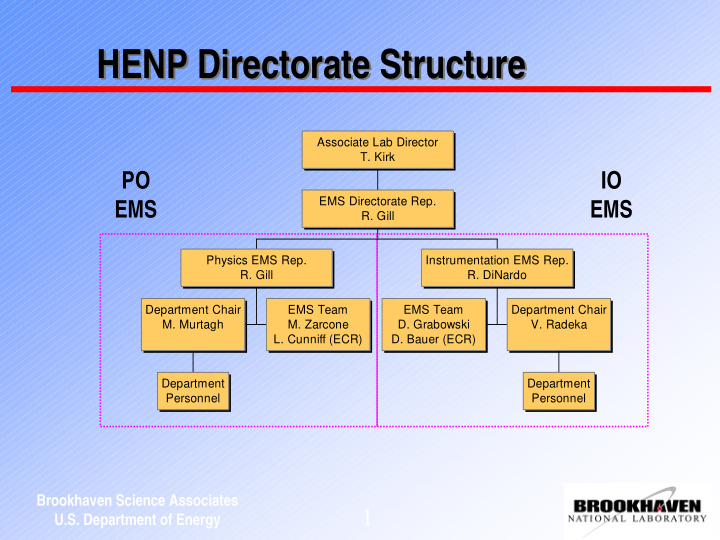



HENP Directorate Structure HENP Directorate Structure Associate Lab Director T. Kirk PO IO EMS Directorate Rep. EMS EMS R. Gill Physics EMS Rep. Instrumentation EMS Rep. R. Gill R. DiNardo Department Chair EMS Team EMS Team Department Chair M. Murtagh M. Zarcone D. Grabowski V. Radeka L. Cunniff (ECR) D. Bauer (ECR) Department Department Personnel Personnel Brookhaven Science Associates 1 U.S. Department of Energy
EMS Management Review – HENP EMS Management Review – HENP � Program Description � Review of Assessments � Stakeholder Concerns � EMS Improvements � Pollution Prevention Initiatives � Environmental Performance � Financial Investments � Questions & Answers � Program Evaluation by Senior Management Brookhaven Science Associates 2 U.S. Department of Energy
EMS & ESR Connections EMS & ESR Connections Identify Activity and Submit ESR DER & ECR Committee EMS Requirements Review Improvements, etc. Safety EMS Aspect Issues Identification Modification or Annual Update Controls New Aspect Existing Evaluate Develop Include in Do Work Impacts Controls EMP & OCF Modify Revise EMP Approve Systems & OCF Experiment Brookhaven Science Associates 3 U.S. Department of Energy
EMS Program Description – Physics EMS Program Description – Physics � Operations • Small scale experiments & Special areas – ESR process • Machine shops – PEP process � Key Elements – Integration • Aspect identification, controls & management plans integrated into ESR process • Communication – Web pages (EMS information & training) – Weekly meetings with Chair & key personnel – Group Safety Coordinators – Department “All Hands” meetings • EMS Assessments – Integrated into Department self-assessment plan – Integrated with Tier I where effective Brookhaven Science Associates 4 U.S. Department of Energy
Significant Aspects Identified Significant Aspects Identified � Industrial Waste – various oils � Haz. Waste – from small scale experiments: solvents, epoxy, Hg, chems. � Rad. Waste – from decayed sealed sources: an anticipated waste stream � Medical Waste – non-medical use of syringes: epoxy & grease application � Atmos. Dischg. – permit for abrasive saw in shop Brookhaven Science Associates 5 U.S. Department of Energy
Review of Assessments Review of Assessments � Compliance – No Issues • Satellite areas listed & inspected Haz Waste is Main Aspect • 90-Day area maintained • Radioactive waste storage maintained • All permits in order � System – April 2000 Audit • Implementation is good • Improved self-assessment to address findings • Expanded E controls to address concerns Brookhaven Science Associates 6 U.S. Department of Energy
Stakeholder Concerns Stakeholder Concerns � Issues and Actions • Activists – none • Community – none – Personnel give lectures – Involved in BNL open days • Regulators – none Brookhaven Science Associates 7 U.S. Department of Energy
EMS Improvements EMS Improvements � Aspect Analysis Integrated into ESR Process � EMS Maintenance � Compliance Assessment via Tier I’s � Pollution Prevention Explicitly Included � Dept. Web Pages & Internal Shared Files • Aspect identification (ESRs) • EM plans & Operational controls • Training, program descriptions & other information Brookhaven Science Associates 8 U.S. Department of Energy
Pollution Prevention Initiatives Pollution Prevention Initiatives � Hazardous Waste • Antifreeze → recycle • Solder scraps → recycle $ Savings $ • Alkaline batteries → trash • Waste ethanol → sink disposal • Reduced satellite areas 40 → 15 � “Free Table” Resource recovery � Radioactive Source Inventory � Annual Chemical Inventory Brookhaven Science Associates 9 U.S. Department of Energy
Environmental Performance Environmental Performance � Physics Waste Generation 700 600 500 400 Hazardous Industrial 300 Radioactive 200 100 0 CY97 CY98 CY99 CY00 Brookhaven Science Associates 10 U.S. Department of Energy
Environmental Performance Environmental Performance � Objectives • EMS implementation complete, milestones met • Compliance with Regs Integrated into ESR & Tier I process • P2/waste reduction � Performance Measures (Goals) • PEP corrective actions (95%) → 100% • Evaluate & disposition APC (25%) → 40% • Prioritize & evaluate P2 opportunity (1) → 2 • Tier I inspections → 97% on time, 33% with ECR Brookhaven Science Associates 11 U.S. Department of Energy
Financial Investments Financial Investments � Time & Effort • Physics → 1,200 ± 10% person-hours • ECR (included above) → 0.3 FTE � Other Resources • Web servers → minimal additional costs � Sustaining EMS • Physics → 0.3 FTE • ECR → 0.3 FTE Brookhaven Science Associates 12 U.S. Department of Energy
EMS Management Review – Physics EMS Management Review – Physics � Questions & Answers • Your particular questions on EMS � Senior Management EMS Program Evaluation • Identify possible improvement actions → assign responsibility to track & implement • Suggestions will be recorded & actions taken. • Five general topics Brookhaven Science Associates 13 U.S. Department of Energy
Senior Management EMS Evaluation Senior Management EMS Evaluation Effective in Achieving Policy � Commitments? � Effective in Achieving Objectives & Performance Measures? � Is EMS Adequate in Terms of: • Identification of significant aspects & impacts? • Resource allocation? • Information systems? Brookhaven Science Associates 14 U.S. Department of Energy
Senior Management EMS Evaluation Senior Management EMS Evaluation Objectives & Performance � Measures Suitable in Terms of: • Impacts & current conditions? • Concerns of stakeholders? • Current & future regulatory requirements? • Internal organizational or process changes? � Recommend Revisions to: • Environmental policy & commitments? • Objectives & performance measures? • Elements of EMS? Brookhaven Science Associates 15 U.S. Department of Energy
Recommend
More recommend